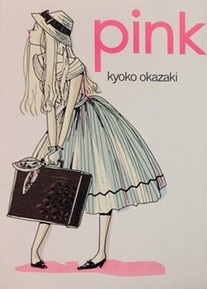Review
by Rebecca Silverman,Pink
GN
| Synopsis: |  |
||
Yumi leads a double life – she works in an office during the day, but at night she makes her real living as a call girl. The latter job seems to suit her better, mostly because it pays more and she can keep her beloved pet crocodile, Croc, in meat. Yumi's younger sister Keiko pops by now and then and lets Yumi in on the fact that her mother, Yumi's hated step-mother, is having an affair with a young man. When Yumi and Haru meet up, a capitalist Snow White story begins in the days before the economic bubble burst. |
|||
| Review: | |||
First published in 1989, incomparable josei mangaka Kyōko Okazaki's tale of a girl caught up in a capitalistic, hedonistic life isn't as harsh, as gritty, or as visceral as her previous English-language release, Helter-Skelter, but it still packs a punch. Full of casual sex, vicious retaliations, and general happy dishonesty, Pink is a strangely captivating read. The story follows Yumi, a young twenty-something who has left her family home to do her own thing. Since she can't support her pet crocodile, Croc, on that salary – or maybe just because she wants more money in general – Yumi holds down a second job as a call girl, a prostitute who goes to hotels to meet her clients. She doesn't seem to mind the paid sex, and she really loves the pay – much of her internal monologue is thinking about what she wants to buy next, or how much it costs to feed Croc. Money and the need (or want) for it drives the story of Pink, defining the choices Yumi makes. Other characters certainly like money, but no one seems quite as involved with it as Yumi. Her step-mother, the once beautiful second wife and mother of Keiko, is motivated by her fading beauty. She indulges in plastic surgery, sex with a much younger man, and hatred of her lovely step-daughter. Even if there were no actual mention of “Snow White,” which there is, it would be very obviously a parallel between Pink and that fairy tale. This step-mother, unlike the famous wicked queen, does not opt for child murder, but her choice is still cruel and vicious and motivated by a very similar feeling. It is interesting to think about her jealousy as being in part driven by spurned sexual advances, as one of the academic theories about the Snow White story is that the father – the man who looks at both women – is actually the magic mirror. That this role is handled by Haru, the young man originally sleeping with the step-mother, is a fascinating twist on this, and Okazaki's inclusion of the fairy tale opens up some new readings of the text. As with Helter-Skelter, Pink's art is likely to be difficult for readers unaccustomed to the less-polished look of some josei manga. There is a very deliberate casualness to Okazaki's art, one that invites us to see the grim underbelly of the story. The art uses very little black or gray, and like the plot itself rarely shies away from depicting sexual situations, although for all of the instances of oral sex we do not see a single penis, or even an implied one. Female nudity is abundant, and implication is an especial strong suit of the artwork – one scene, where Keiko brings a neighbor's poodle she dislikes to Croc as a snack, has strong implications of what's going on, even though we (thankfully) never see what's happening. One of the most interesting characters in the book is Keiko, Yumi's younger half-sister. Allowed to go out at all hours of the night, perfectly aware of her sister's second profession and not above quietly watching Yumi and Haru have sex, there's something frightening about the girl. Yumi is totally comfortable in her life choices, Haru is the picture of uncertain youth not sure which way to turn or what to do, and the step-mother owns her problems and her decisions. These are the people – plus the totally absent father – who are raising Keiko, and in all of them we can see glimpses of who the girl could become. Okazaki never hints at what Keiko's life will be after the story ends, and it is her future that is the most uncertain. Will she grow up to be a character in Helter-Skelter? Another version of her mother? There does seem to be a link between Okazaki's two titles, and it is possible to see how the little girl of the economic bubble could grow up to be the tormented cynic of a future Japan. On the whole, Pink is more than what it appears on the surface. The sweetness of the color, the harmless image of princesses and sparkles, both of which carry monetary connotations, is only a surface affectation, like the nail polish Yumi remembers her birth mother wearing, covering up the plain nails underneath. In the case of Pink, those nails are of the metal kind, and they are sharp, poking Yumi, Haru, and the step-mother when they least expect it...even if they pretend that they don't notice. |
|
The views and opinions expressed in this article are solely those of the author(s) and do not necessarily represent the views of Anime News Network, its employees, owners, or sponsors.
|
| Grade: | |||
Overall : A-
Story : A-
Art : B-
+ Much more going on than at first appears, interesting use of the Snow White story. Very nice presentation by Vertical. |
|||
| discuss this in the forum (5 posts) | | |||
| Production Info: | ||
|
Full encyclopedia details about Release information about |
||